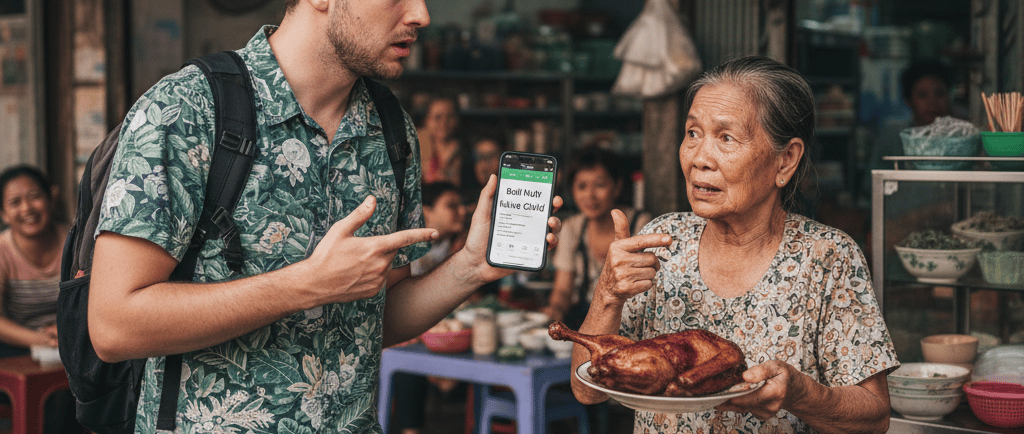How Language Translation Fuels Tourism Growth in Vietnam: Lost in Translation, Found in Tourism
Language translation is crucial for Vietnam's tourism boom, boosting traveler confidence, bridging cultural gaps, and minimizing hilarious-but-problematic communication errors.
THIRD LANGUAGECULTUREASIAMARKETINGBILINGUALEXPANSIONCULTUREVIETNAMESE LANGUAGEDIALECTSLANGUAGESTIPS & TRICKSMULTILINGUALASIAN LANGUAGESTRANSLATIONTRANSLATORSOUTHEAST ASIAVIETNAMESEASEANTOURISM
10/3/20253 min read


How Language Translation Fuels Tourism Growth in Vietnam: Lost in Translation, Found in Tourism
Vietnam, with its stunning landscapes, rich history, and mouth-watering phở, is a global superstar in the making, boasting over 17.5 million international visitors in 2024. But behind the perfect Instagram shots of Hạ Long Bay lies a silent, powerful engine driving this growth: language translation. It's the unsung hero, the digital and human bridge ensuring tourists don't accidentally order "Boil Half a Child" instead of a traditional Vietnamese dish. (Yes, that was a real, and thankfully rare, menu typo!)
The Confidence of Comprehension
For a tourist, travel is often about feeling a little lost, but not completely bewildered. Language translation—from professional services to friendly hotel staff speaking English for Specific Purposes (ESP)—provides the crucial confidence for foreign travelers to book their trips.
Imagine trying to navigate a website for a multi-day trek or a complex visa application without clear English instructions. You’d probably click away! High-quality translation of tourism promotional materials (TPMs), like websites, brochures, and travel blogs, is essential for conveying the rich nuances of Vietnam's culture and its natural beauty. It’s what turns an indecisive potential visitor into a paying customer. In essence, translation isn't just a cost; it's the first step in the sales funnel.
Navigating the Daily Life and the Humour
Once tourists arrive, translation transforms from a marketing tool into a necessity for survival and enjoyment. This is where the magic, and sometimes the comedy, happens.
In urban centers like Hanoi and Ho Chi Minh City, hotels, major sites, and airport signage are often reliably translated. However, venture into a local restaurant or a smaller museum, and the literal-translation gremlins sometimes pop out.
* Menu Mayhem: Tourists have encountered menu items that translate literally into bizarre and hilarious phrases, often due to an over-reliance on basic machine translation. While a sign reading “Please enjoy the delicious fresh fat cock” (a mistranslation of a deep-fried chicken dish) certainly grabs attention, a professional, culturally sensitive translation ensures the tourist is ordering a meal, not a potential police report. These little errors, while funny, highlight the real value of human, context-aware translation in preventing confusion and preserving a professional image.
* Signage Saves the Day: Clear, accurate signs prevent travelers from accidentally wandering into a private area or missing a crucial turn. When information is effectively conveyed, the tourist experience is smoother, safer, and more enjoyable, leading to better reviews and more repeat visits.
The Cultural Bridge: Transcreation
Professional translation in tourism goes beyond merely swapping words; it involves transcreation. This means adapting the message to fit the target culture while preserving the original meaning and emotional appeal.
Vietnam’s appeal is often tied to its unique cultural concepts—like the meaning of Tết (Lunar New Year) or the history behind the Áo Dài (traditional dress). A literal translation might miss the deep cultural context of these terms. A skilled translator acts as a cultural ambassador, ensuring that the English, French, or Korean text not only informs but also evokes the right emotions and respect for the local traditions.
This effort to bridge the cultural gap makes visitors feel more respected and engaged, turning a simple sightseeing trip into a profound cultural immersion—a key factor in the lucrative experiential travel market.
Technology: The Handheld Helper
While professional translation is key for permanent materials, technology like smartphone apps and Google Translate has become the tourist's personal, instant interpreter. This allows for immediate, on-the-ground communication with vendors, taxi drivers, and locals who don't speak a foreign language.
These instant tools help tourists feel empowered and less intimidated by the language barrier, encouraging them to explore deeper into non-touristy areas. This decentralization of travel spending benefits a wider segment of the Vietnamese economy, fueling growth beyond the main tourist hubs.
In conclusion, as Vietnam continues its remarkable tourism growth—with a projected focus on increasing arrivals—investing in professional, accurate, and culturally sensitive translation remains paramount. It’s the essential tool that ensures millions of international visitors can appreciate the country’s beauty without getting lost, confused, or accidentally ordering something deeply unsavory from a poorly translated menu.
8 Funny literal translations from Vietnamese to English
This video is relevant as it provides humorous examples of literal translations from Vietnamese to English, illustrating the importance of professional translation in the tourism sector to avoid confusion and funny errors.
YouTube video views will be stored in your YouTube History, and your data will be stored and used by YouTube according to its Terms of Service
Translations
Expert translations for businesses and individuals worldwide.
© 2024. All rights reserved.
